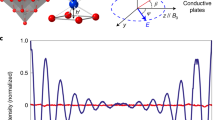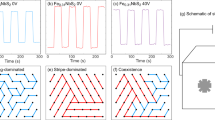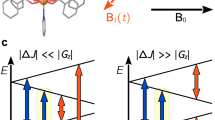Abstract
A current of spin-polarized electrons senses and controls the magnetic state of nanostructured materials1. Obtaining similar electrical access to quantum spin systems, such as single-molecule magnets, is still in its infancy2. Recent progress has been achieved by probing the spin system near thermal equilibrium3,4,5,6,7,8,9. However, it is the elusive non-equilibrium properties of the excited states that govern the time evolution of such structures and will ultimately establish the feasibility of applications in data storage2,10 and quantum information processing11,12. Here we use spin-polarized scanning tunnelling microscopy13 to pump electron spins of atoms on surfaces into highly excited states and sense the resulting spatial orientation of the spin. This electrical control culminates in complete inversion of the spin-state population and gives experimental access to the spin relaxation times of each excited state. The direction of current flow determines the orientation of the atom’s spin, indicating that electrical switching and sensing of future magnetic bits is feasible in the quantum regime.
This is a preview of subscription content, access via your institution
Access options
Subscribe to this journal
Receive 12 print issues and online access
$259.00 per year
only $21.58 per issue
Buy this article
- Purchase on SpringerLink
- Instant access to full article PDF
Prices may be subject to local taxes which are calculated during checkout




Similar content being viewed by others
References
Chappert, C., Fert, A. & Van Dau, F. N. The emergence of spin electronics in data storage. Nature Mater. 6, 813–823 (2007).
Bogani, L. & Wernsdorfer, W. Molecular spintronics using single-molecule magnets. Nature Mater. 7, 179–186 (2008).
Grose, J. E. et al. Tunnelling spectra of individual magnetic endofullerene molecules. Nature Mater. 7, 884–889 (2008).
Park, J. et al. Coulomb blockade and the Kondo effect in single-atom transistors. Nature 417, 722–725 (2002).
Liang, W., Shores, M. P., Bockrath, M., Long, J. R. & Park, H. Kondo resonance in a single-molecule transistor. Nature 417, 725–729 (2002).
Hirjibehedin, C. F., Lutz, C. P. & Heinrich, A. J. Spin coupling in engineered atomic structures. Science 312, 1021–1024 (2006).
Chen, X. et al. Probing superexchange interaction in molecular magnets by spin-flip spectroscopy and microscopy. Phys. Rev. Lett. 101, 197208 (2008).
Tsukahara, N. et al. Adsorption-induced switching of magnetic anisotropy in a single iron(II) phthalocyanine molecule on an oxidized Cu(110) surface. Phys. Rev. Lett. 102, 167203 (2009).
Hirjibehedin, C. F. et al. Large magnetic anisotropy of a single atomic spin embedded in a surface molecular network. Science 317, 1199–1203 (2007).
Thomas, L. et al. Macroscopic quantum tunnelling of magnetization in a single crystal of nanomagnets. Nature 383, 145–147 (1996).
Leuenberger, M. N. & Loss, D. Quantum computing in molecular magnets. Nature 410, 789–793 (2001).
Ardavan, A. et al. Will spin-relaxation times in molecular magnets permit quantum information processing? Phys. Rev. Lett. 98, 057201 (2007).
Bode, M. Spin-polarized scanning tunnelling microscopy. Rep. Prog. Phys. 66, 523–582 (2003).
Gatteschi, D., Sessoli, R. & Villain, J. Molecular Nanomagnets (Oxford Univ. Press, 2006).
Heinrich, A. J., Gupta, J. A., Lutz, C. P. & Eigler, D. M. Single-atom spin-flip spectroscopy. Science 306, 466–469 (2004).
Choi, T., Ruggiero, C. D. & Gupta, J. A. Incommensurability and atomic structure of c(2×2)N/Cu(100): A scanning tunnelling microscopy study. Phys. Rev. B 78, 035430 (2008).
Stipe, B. C., Rezaei, M. A. & Ho, W. Single-molecule vibrational spectroscopy and microscopy. Science 280, 1732–1735 (1998).
Balashov, T. et al. Inelastic electron–magnon interaction and spin transfer torque. Phys. Rev. B 78, 174404 (2008).
Fernandez-Rossier, J. Theory of single-spin inelastic tunneling spectroscopy. Phys. Rev. Lett. 102, 256802 (2009).
Fransson, J. Spin inelastic electron tunneling spectroscopy on local spin adsorbed on surface. Nano Lett. 9, 2414–2417 (2009).
Persson, M. Theory of inelastic electron tunneling from a localized spin in the impulsive approximation. Phys. Rev. Lett. 103, 050801 (2009).
Lorente, N. & Gauyacq, J. P. Efficient spin transitions in inelastic electron tunneling spectroscopy. Phys. Rev. Lett. 103, 176601 (2009).
Kirschner, J. Direct and exchange contributions in inelastic scattering of spin-polarized electrons from iron. Phys. Rev. Lett. 55, 973–976 (1985).
Myers, E. B., Ralph, D. C., Katine, J. A., Louie, R. N. & Buhrman, R. A. Current-induced switching of domains in magnetic multilayer devices. Science 285, 867–870 (1999).
Slonczewski, J. C. Current-driven excitation of magnetic multilayers. J. Magn. Magn. Mater. 159, L1–L7 (1996).
Moodera, J. S., Kinder, L. R., Wong, T. M. & Meservey, R. Large magnetoresistance at room temperature in ferromagnetic thin film tunnel junctions. Phys. Rev. Lett. 74, 3273–3276 (1995).
Leuenberger, M. N. & Loss, D. Spin relaxation in Mn12-acetate. Europhys. Lett. 46, 692–698 (1999).
Delgado, F., Palacios, J. J. & Fernandez-Rossier, J. Spin-transfer torque on a single magnetic adatom. Phys. Rev. Lett. 104, 026601 (2010).
Bartels, L., Meyer, G. & Rieder, K.-H. Controlled vertical manipulation of single Co molecules with the scanning tunneling microscope: A route to chemical contrast. Appl. Phys. Lett. 71, 213–215 (1997).
Meier, F., Zhou, L., Wiebe, J. & Wiesendanger, R. Revealing magnetic interactions from single-atom magnetization curves. Science 320, 82–86 (2008).
Kreuzer, H. J. Nonequilibrium Thermodynamics and its Statistical Foundations (Clarendon, 1981).
Acknowledgements
We thank D. Eigler for mentoring and great discussions, C. Hirjibehedin for suggesting the importance of spin-dependent elastic tunnelling and B. Melior for expert technical contributions. S.L. acknowledges support from the Alexander von Humboldt Foundation; K.v.B. from the German Research Foundation (DFG) (Forschungsstipendium); A.F.O. from the Leiden University Fund; and S.L., M.T., C.P.L. and A.J.H. from the Office of Naval Research.
Author information
Authors and Affiliations
Contributions
All authors conducted the experiments and contributed to the preparation of the paper, S.L., C.P.L. and A.J.H. developed the rate equation model, S.L. and K.v.B. analysed the data.
Corresponding author
Ethics declarations
Competing interests
The authors declare no competing financial interests.
Supplementary information
Supplementary Information
Supplementary Information (PDF 519 kb)
Rights and permissions
About this article
Cite this article
Loth, S., von Bergmann, K., Ternes, M. et al. Controlling the state of quantum spins with electric currents. Nature Phys 6, 340–344 (2010). https://doi.org/10.1038/nphys1616
Received:
Accepted:
Published:
Issue date:
DOI: https://doi.org/10.1038/nphys1616
This article is cited by
-
Electrically driven spin resonance of 4f electrons in a single atom on a surface
Nature Communications (2024)
-
Evidence for spinarons in Co adatoms
Nature Physics (2024)
-
Universal quantum control of an atomic spin qubit on a surface
npj Quantum Information (2023)
-
Trends in the hyperfine interactions of magnetic adatoms on thin insulating layers
npj Computational Materials (2021)
-
Mathematical modelling of induced magnetisation @ Mn(II) ion doped in perovskite host
Pramana (2021)



